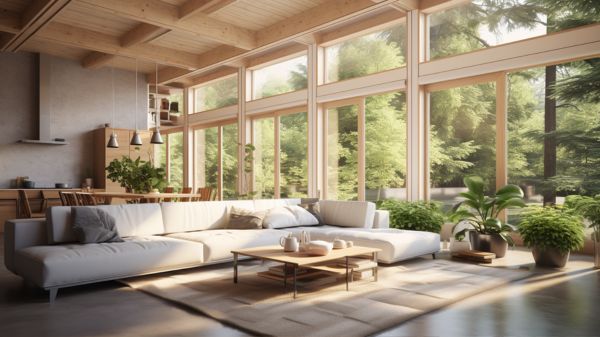Why Opt for Innovative Water Conservation Techniques?
As we strive to protect our planet and secure a sustainable future, it becomes imperative to explore innovative water conservation techniques.
In this article, we will delve into the benefits of these techniques, examine successful projects, and explore how technology is transforming water conservation.
Additionally, we will discuss the role of education in promoting innovative methods, the challenges faced in implementing them, and the future of water conservation through embracing innovation.
Let us embark on this journey together, united in our quest for a greener world.
Benefits of Innovative Water Conservation Techniques
One of the key benefits of using innovative water conservation techniques is that they allow us to make the most out of our limited water resources. Implementing these techniques can significantly reduce water usage and wastage, ensuring a more sustainable and efficient water management system. By utilizing methods such as rainwater harvesting, graywater recycling, and xeriscaping, we can conserve water for future generations while still meeting our present needs.
Additionally, innovative water conservation techniques can help mitigate the challenges posed by water scarcity and drought conditions. These techniques promote a more responsible and mindful approach to water consumption, reducing the strain on water sources. They also encourage awareness and education about the importance of water conservation in our daily lives.
Furthermore, implementing innovative water conservation techniques can lead to financial benefits for individuals, businesses, and communities. By conserving water, we can reduce water bills, decrease the need for costly infrastructure projects, and create a more sustainable economy.
Examples of Successful Innovative Water Conservation Projects
When looking at examples of successful innovative water conservation projects, it becomes evident that these techniques have a significant impact on water conservation efforts. By implementing innovative solutions, such as rainwater harvesting systems or efficient irrigation methods, communities and organizations have been able to achieve substantial water savings.
Moreover, these projects have proven to be cost-effective, providing long-term benefits while minimizing expenses.
As we explore these successful case studies, it’s essential to consider how we can replicate and adapt these techniques to address water scarcity challenges worldwide.
Impact of Innovative Techniques
Our organization’s innovative water conservation techniques have had a significant impact, as demonstrated by the success of several projects. These projects have undergone rigorous impact assessments, providing valuable insights into the effectiveness of our techniques and their broader policy implications.
- Improved Irrigation Systems: By implementing state-of-the-art irrigation technologies, we’ve reduced water consumption by up to 30%, resulting in increased crop yields and decreased strain on local water resources.
- Rainwater Harvesting: Our innovative rainwater harvesting systems have allowed communities to collect and store rainwater for various purposes, reducing their reliance on groundwater sources and mitigating the risk of water scarcity during dry seasons.
- Water Recycling and Reuse: Through advanced water treatment processes, we’ve successfully recycled and reused wastewater for non-potable purposes, such as irrigation and industrial applications, conserving freshwater resources and minimizing pollution.
These successful projects highlight the tangible benefits of our innovative water conservation techniques, providing a roadmap for sustainable water management practices and inspiring further policy development.
Cost-Effective Conservation Solutions
Finding cost-effective conservation solutions is crucial in addressing water scarcity and promoting sustainable water management. Through the implementation of innovative techniques and projects, we can effectively conserve water resources while minimizing costs.
One example of a successful innovative water conservation project is the use of rainwater harvesting systems. These systems collect and store rainwater for various purposes such as irrigation, toilet flushing, and laundry. By utilizing rainwater, households and businesses can reduce their reliance on freshwater sources, leading to significant cost savings.
Another cost-effective solution is the implementation of water-efficient technologies, such as low-flow fixtures and smart irrigation systems. These technologies optimize water usage by reducing wastage and ensuring that water is used only when needed. This not only helps conserve water but also results in reduced water bills for consumers.
Replicating Successful Projects
One approach to replicating successful innovative water conservation projects is by studying and adapting their methods and strategies. By analyzing projects that have achieved significant water savings and implementing their techniques on a larger scale, we can effectively address water scarcity issues. This strategy involves scaling up successful initiatives and applying them to similar contexts or communities facing similar challenges.
To replicate successful projects, it’s essential to engage the community. Community engagement ensures that local stakeholders are involved in decision-making processes, leading to higher acceptance and implementation of water conservation measures. By fostering a sense of ownership and participation, communities are more likely to adopt and sustain water-saving practices in the long run.
Key considerations for replicating successful projects include:
- Identifying and understanding the unique challenges and opportunities of each community or region.
- Customizing strategies to suit local conditions and cultural norms.
- Providing training, education, and ongoing support to ensure successful implementation and maintenance of water conservation measures.
How Innovative Technologies Are Transforming Water Conservation
Innovative technologies have revolutionized water conservation practices, offering effective solutions to address the growing water scarcity issues.
Improved irrigation systems, such as drip and precision irrigation, optimize water usage by delivering water directly to the roots of plants, minimizing wastage.
Smart metering solutions enable accurate monitoring and measurement of water consumption, empowering users to identify and address inefficiencies.
Additionally, rainwater harvesting methods capture and store rainwater for various uses, reducing reliance on freshwater sources.
These innovative technologies play a crucial role in transforming water conservation efforts and promoting sustainable water management practices.
Improved Irrigation Systems
We have witnessed significant advancements in irrigation systems that are revolutionizing water conservation techniques. These improved irrigation systems play a crucial role in promoting sustainable agriculture by maximizing water efficiency and minimizing water waste.
Here are three key ways in which these innovative technologies are transforming water conservation:
- Precision Irrigation: Advanced irrigation systems use sensors and real-time data to deliver the right amount of water directly to the plant’s root zone. This precision ensures that crops receive optimal hydration, leading to improved crop yields and reduced water consumption.
- Drip Irrigation: This technique involves delivering water directly to the plant’s roots through a network of tubes or pipes with small emitters. Drip irrigation minimizes water loss due to evaporation or runoff, making it a highly efficient method for watering crops.
- Smart Irrigation Controllers: These controllers use weather data and soil moisture sensors to determine when and how much water to apply. By adjusting irrigation schedules based on actual plant needs, smart controllers optimize water usage and prevent overwatering.
Smart Metering Solutions
Smart metering solutions are revolutionizing water conservation by providing real-time data and insights into water usage. These innovative technologies play a crucial role in smart water management and water consumption monitoring.
With smart metering solutions, individuals and organizations can monitor their water consumption patterns and identify areas for improvement. By having access to real-time data, users can make informed decisions about water usage, implement strategies to reduce wastage, and optimize water conservation efforts.
Smart meters track water usage at regular intervals and provide accurate readings, eliminating the need for manual readings and reducing human error. The data collected by smart meters can be analyzed to identify trends, patterns, and anomalies, enabling users to detect leaks, assess the effectiveness of water-saving measures, and make data-driven decisions to conserve water.
Rainwater Harvesting Methods
By implementing advanced technologies, we can now explore the effective rainwater harvesting methods that are transforming water conservation efforts. Rainwater harvesting is a crucial technique in water management, especially in regions facing water scarcity. With innovative technologies, we can maximize the collection and utilization of rainwater, reducing the strain on traditional water sources.
Here are three key rainwater harvesting methods:
- Rooftop collection: Rainwater is collected from rooftops and channeled into storage tanks or reservoirs for later use. This method is cost-effective and can be easily implemented in both urban and rural areas.
- Surface runoff harvesting: Rainwater is collected from surfaces such as roads, pavements, and open areas, and directed towards storage systems. This method helps prevent water wastage and replenishes groundwater.
- Infiltration pits and trenches: These structures are designed to capture and store rainwater underground, allowing it to seep into the soil and recharge aquifers. This method helps replenish groundwater levels and reduces surface runoff.
The Role of Education in Promoting Innovative Water Conservation Methods
One way to promote innovative water conservation methods is by educating individuals on their importance and implementation.
The role of awareness and community involvement in this process can’t be overstated. By raising awareness about the scarcity of water resources and the need for conservation, education can help individuals understand the urgency and significance of adopting innovative techniques.
It can also empower them with the knowledge and skills necessary to implement these methods in their daily lives. Education plays a vital role in fostering a sense of responsibility and ownership among individuals towards water conservation.
Challenges and Solutions in Implementing Innovative Water Conservation Techniques
Implementing innovative water conservation techniques can present various challenges, but with collective effort and effective solutions, these obstacles can be overcome. It’s crucial to address these challenges head-on in order to successfully implement innovative water conservation techniques.
Some of the challenges in implementing innovative techniques include:
- Resistance to change: Many individuals and organizations may be resistant to adopting new techniques, especially if they disrupt established practices. Overcoming this resistance requires education, awareness, and showcasing the benefits of these techniques.
- Lack of infrastructure: Implementing innovative techniques often requires new infrastructure or modifications to existing systems. This can be costly and time-consuming, requiring careful planning and coordination.
- Limited funding: Adequate funding is essential for implementing innovative techniques on a large scale. Encouraging public-private partnerships and securing government support can help address this challenge.
Solutions for implementing innovative techniques include:
- Education and awareness campaigns: Providing information and raising awareness about the importance and benefits of innovative water conservation techniques can help overcome resistance and garner support.
- Incentives and subsidies: Offering financial incentives and subsidies can encourage individuals and organizations to adopt innovative techniques, helping to overcome the barrier of limited funding.
- Collaboration and knowledge sharing: Collaborating with stakeholders, sharing best practices, and fostering innovation can lead to effective solutions and help overcome challenges in implementing innovative techniques.
The Future of Water Conservation: Embracing Innovation
As we look ahead, we must embrace innovative water conservation techniques to ensure a sustainable future for our water resources.
The future of water conservation lies in the adoption of strategies that future-proof our water supply and promote sustainable water management.
With the increasing demand for water and the potential impact of climate change, it’s crucial to develop innovative solutions that can effectively address these challenges.
By implementing technologies such as smart irrigation systems, rainwater harvesting, and water-efficient fixtures, we can optimize water use and minimize wastage.
Additionally, incorporating advanced data analytics and monitoring systems can provide valuable insights into water usage patterns, leading to more informed decision-making.
Embracing innovation in water conservation isn’t only essential for our immediate needs but also for the long-term sustainability of our water resources.
Conclusion
In conclusion, embracing innovative water conservation techniques is crucial for ensuring a sustainable future.
One interesting statistic to highlight is that according to a study by the United Nations, implementing innovative technologies in water conservation can reduce water consumption by up to 50%.
This emphasizes the significant impact that innovative approaches can have in addressing the global water crisis and preserving this vital resource for generations to come.






